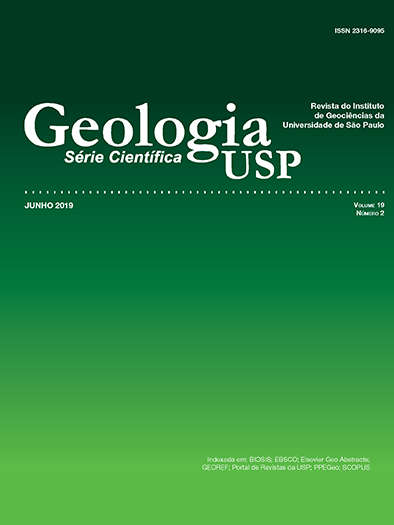Stratigraphic evolution of the cretaceous deposits from the northern portion of the São Luís-Grajaú Basin (NE of Brazil)
DOI:
https://doi.org/10.11606/issn.2316-9095.v19-152654Keywords:
Parnaíba Province, São Luís-Grajaú Basin, Sequence Stratigraphy, Codó Formation, Grajaú Formation, Itapecuru GroupAbstract
Cretaceous deposits of the São Luís-Grajaú Basin are recurrently organized, on previous works, in three depositional sequences, consolidated from Late Aptian to an uncertain age in Late Cretaceous, covering the Grajaú and Codó formations, as well as the Itapecuru Group. This work aimed to apply sequence stratigraphy, based on the correlation of lithological and gamma-ray profiles, in the analysis of the Cretaceous deposits located in the northern part of the basin. For this purpose, the researchers used data from five wells, interpreted in a 1D stage, which later served as the basis for the construction of a stratigraphic section, interpreted in a 2D phase. In addition, previous work about the depositional systems involved in the sedimentation of these Cretaceous deposits was compared to propose an evolutionary model for the studied interval. The integration of these interpretations allowed the individualization of the interval in two depositional sequences (A and B), each one consisting of three systems tracts: lowstand (LST), transgressive (TST) and highstand (HST). Sequence A was primarily dominated by fluvial-deltaic processes, corresponding to the LST. Later, representing the TST, there was the expansion of lake facies, parallel to the retraction of the fluvial-deltaic system developed during the previous phase. Finally, characterizing the HST, there was a continuation of the suspensive processes seen in the TST, but with the influence of hyperpycnal flows. Regarding Sequence B, it was initially marked by the installation of a delta system representative of the LST. Subsequently, in the TST, that delta gave rise to a wave-dominated estuary. Finally, in a stage assigned to the HST, a delta system was reestablished, thus closing the evolutionary history
Downloads
Downloads
Published
Issue
Section
License
Authors who publish in this journal shall comply with the following terms:
- Authors keep their copyright and grant to Geologia USP: Série Científica the right of first publication, with the paper under the Creative Commons BY-NC-SA license (summary of the license: https://creativecommons.org/licenses/by-nc-sa/4.0 | full text of the license: https://creativecommons.org/licenses/by-nc-sa/4.0/legalcode) that allows the non-commercial sharing of the paper and granting the proper copyrights of the first publication in this journal.
- Authors are authorized to take additional contracts separately, for non-exclusive distribution of the version of the paper published in this journal (publish in institutional repository or as a book chapter), granting the proper copyrights of first publication in this journal.
- Authors are allowed and encouraged to publish and distribute their paper online (in institutional repositories or their personal page) at any point before or during the editorial process, since this can generate productive changes as well as increase the impact and citation of the published paper (See The effect of Open Access and downloads on citation impact).





